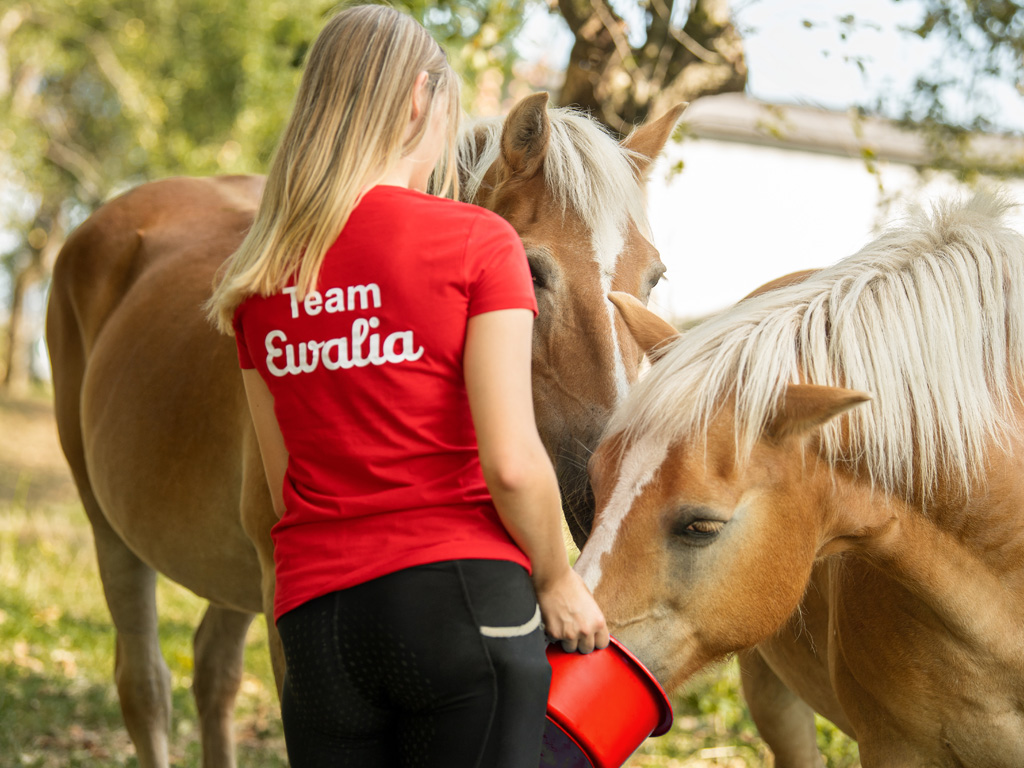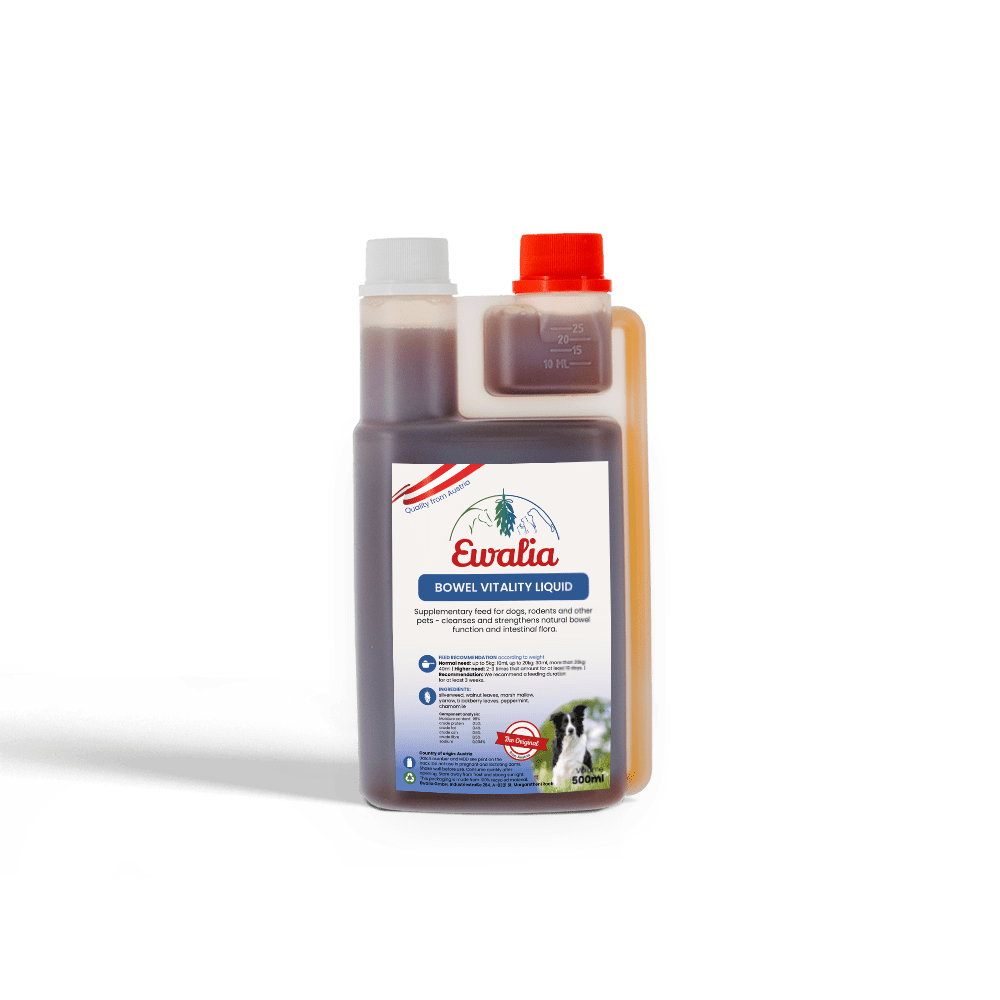Stomach problems in dogs

The dog's stomach: An overview of digestion and gastrointestinal problems Bad bloating, frequent vomiting, fatigue, dull fur and a personality change in our faithful four-legged companion make our alarm bells ring. Although the dog stomach is very robust, various factors can cause it to become unbalanced. Here is a brief overview of the stomach function and digestion of your dog, what you should pay attention to and how to recognise any problems in the gastrointestinal area early.
Did you know...?
... that the dog stomach has a very large capacity and your dog can consume a very large amount of food at one time?
... that the pH in the dog stomach is between 1 and 1.5 and thus significantly more acidic than a human stomach?
...that no digestive processes take place in the mouth, but that actual digestion only starts in the stomach?
... that your dog's stomach is very poorly attached in the body and therefore a stomach twist can happen very easily, especially in flat-breasted and big dogs?
...that food that was ingested only leaves the dog's body after 24-36 hours?
...that the main digestive phase in the small intestine lasts only 1-2 hours?
... that the digestive juices are formed in the intestinal mucosa, liver (bile) and pancreas?
... that bloating and inflammation of the gastrointestinal tract are particularly painful due to the many nerve cells present?
How does digestion work in dogs?
The dog is a carnivore and therefore has a relatively short intestine compared to herbivorous species. Unlike in humans, digestion does not start in the mouth with chewing, but only once the food reaches the stomach. Dogs, like their ancestors the wolves, are hunters. The teeth are used primarily to "slay" the prey and for initial crushing. The saliva contains no digestive enzymes and only facilitates the transport from the mouth through the rather narrow oesophagus into the stomach.

In comparison to other animals, the stomach is very big. This is because the wolf did not get his portions presented twice daily in a bowl, but rather devoured parts of the killed prey quickly, and then retched them up again and buried them for later consumption. Since freshly killed prey animals were relatively rare, nature ensured, by a very low pH value, that even slightly decayed animal remains can be digested in the stomach. Hydrochloric acid is produced throughout the stomach and produces a pH level of 1-1.5. The acid activates enzymes for protein digestion and the contents of the stomach are slowly released to the small intestine in small portions.
The small intestine is the main digestion site, so to speak. Here, proteins, carbohydrates and fats are broken down further and absorbed through the intestinal wall. This process is quite short (1-2 hours) when measured against the whole digestive process.
The remaining bolus lingers longer in the large intestine. Nutrients that are difficult to digest and water are broken down and absorbed in the large intestine.
Other important digestive organs are the liver and pancreas, which are directly connected. The liver, which is actually the detoxification organ, activates bile as a secondary function. The bile is responsible for the formation of micelles (a change to fat particles so that they can be absorbed through the intestinal wall) and sends another impulse to the pancreas. The function of the pancreas is to split fat cells. It produces the enzyme needed for this process, called "lipase". Diseases of the pancreas can be identified by so-called fatty stool, in which fats are excreted undigested.
How do I recognise digestive problems?
Sudden diarrhoea, nausea or vomiting do not necessarily mean a serious illness. An accurate, daily observation of the behaviour of your faithful companion will quickly alert you when something is out of balance. Your dog could just have eaten something unsuitable on this occasion. However, if vomiting and diarrhoea carry on, your dog looks tired or behaves conspicuously differently you should investigate the matter more closely. Here is a short list of possible signs of severe digestive problems:
- repeated, persistent vomiting
- sour smell from the mouth
- persistent diarrhoea or constipation
- loss of strength, constant tiredness
- dull, brittle coat
- frequent burping
- badly digested or undigested fragments in the faeces
- bloating
- weight loss or overweight
Not all the signs will occur simultaneously. We recommend that you consult a veterinarian for further diagnosis and clarification in case of persistent digestive problems.
Amorim et al. mentions a very wide range of possible diseases in his review. These range from rather innocuous acute gastritis, chronic gastritis, gastric ulcers, infections and parasite infestation to tumours. Diagnosis and therapy are sometimes very cost-intensive and expensive, depending on the clinical picture. It is therefore advisable to pay special attention to your four-legged friend's digestive tract.
How can I avoid stomach problems in my dog?
The most important factor for preventing stomach and digestive problems in dogs is appropriate nutrition, adapted to the needs of the dog. We can't tell you here whether barf feeding or wet or dry food is the right choice for your dog. Every type of food has advantages and disadvantages that have to be taken into account. In the case of barf feeding, care should be taken that the meat is of high quality, the diet is varied and that it contains sufficient carbohydrates and crude fibre. Wet food should not contain any additional preservatives, flavours or sugars and should also contain a mixture of proteins, carbohydrates and fats that is suitable for dogs. When feeding dry food, the quality and composition are equally important. Water intake, feeding times and quantity are other important criteria when feeding dry food.
Stomach problems are particularly noticeable in dogs in competition sports. Because of their intensive training, four-legged athletes have an increased calorie requirement as well as a higher stress load. Studies of dogs in racing have shown that stomach disorders are a frequent cause of death. A 50-70% increase in frequency of significant gastric mucosal lesions in sled dogs may be expected on a single training day. Comparative studies show that the longer the duration of training (different disciplines such as trail, explosives search, sled dogs, etc.), the higher the probability of changes or damage to the gastric mucosa in dogs. Continuous stress seems to be the main cause of this.
In summary, the following are the main points to observe in taking care of the stomach:
- Feeding high-quality food that is adapted to the needs of the species
- Ensuring that the dog has enough to drink!
- Having sufficient breaks in intensive training phases and reducing stress
- Reducing general everyday stress
- Planning in rest phases for the dog after feeding large quantities
- Regular check-ups of the teeth
- Regular parasite prevention like deworming
- Sufficient daily exercise and activity!
Which herbs support my dog's stomach?
Licorice has a protective, antiviral, mucosal action, accelerates the healing of gastric ulcers and locally increases the prostaglandin concentration in the gastric mucosa.
Okra also protects the mucosa and reduces irritation in the stomach.
Camomile has a digestive and carminative (anti-bloating) effect.
Lavender is used for nervous gastrointestinal disorders.
Yarrow has an appetite-stimulating and digestive effect.
Which herbs support my dog's intestine?
Silverweed is used for acute diarrhoea and stomach cramps in veterinary medicine.
Walnut leaves have an anti-inflammatory effect.
Blackberry leaves have antiviral, antibacterial and anti-inflammatory properties and are also used for acute diarrhoea.
Peppermint is used for spasmodic complaints in the gastrointestinal tract, vomiting and colic.
Which herbs support my dog's liver?
Milk thistle stimulates the regeneration of liver cells and protects against numerous kinds of liver damage.
Artichoke is mainly used in disorders of the liver-bile system and also lowers lipids and cholesterol.
Birch leaves increase the amount of urine and reduces fever.
Dandelion has a digestive and diuretic effect and stimulates bile function.
Compiled by: Bianca Becker-Slovacek on 22/02/2019
Bibliography and further reading
- Amorim I., T. M. (2016). Canine Gastric Pathology: A Review. ScienceDirekt, p. 9-37 Vol. 154.
- Davis Michael S., W. K. (04.. April 2016). Gastritis and Gastric Ulcers in Working Dogs. frontiers in Veterinary Science, S. 1-6, Vol. 3.
- Gnass, S. (2010). Veterinary practice Susanne Gnass. From http://www.tierarztpraxis-wandsbek.de/info-hund/anatomie--physiologie/das-verdauungssystem-von-hunden.html accessed by
- J. Bazelle, A. T. (04 July 2018). Gastroprotectans in small animal veterinary practice - a review of the evidence. Part 1: cyto-protective drugs. Journal of Small Animal Practice 59, p. 587-602.
- (V. Gerber, & R. Straub, eds.) Bern: utb.Reichling, J., Gachnian-Mirtscheva, R., Frater-Schröder, M., Di Carlo, A., & Widmaier, W. (2008). Herbalism for the veterinary practice Berlin-Heidelberg: Springer Medizin Verlag.















